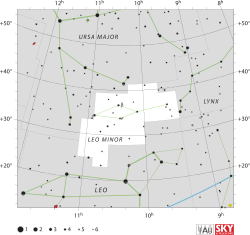37 Leonis Minoris
| 37 Leonis Minoris | |
 | |
| Observationsdata Epok: J2000.0 | |
|---|---|
| Stjärnbild | Lilla lejonet |
| Rektascension | 11t 01m 49,67462s[1] |
| Deklination | -31° 58′ 34,4607″[2] |
| Skenbar magnitud () | +4,68 (V)[3] |
| Stjärntyp | |
| Spektraltyp | G2.5 IIa[4] |
| B–V | +0,823 ± 0,008[3] |
| Astrometri | |
| Radialhastighet () | -8,0 ± 0,3[3] km/s |
| Egenrörelse (µ) | RA: +9,76[1] mas/år Dek.: -35,56[1] mas/år |
| Parallax () | 5,58 ± 0,24[1] |
| Avstånd | 580 ± 30 lå (179 ± 8 pc) |
| Absolut magnitud () | -1,84[5] |
| Detaljer | |
| Massa | 3,72[6] M☉ |
| Radie | 31[7] R☉ |
| Luminositet | 438,33[3] L☉ |
| Temperatur | 5 468[6] K |
| Metallicitet | +0,03(Fe/H)[6] dex |
| Vinkelhastighet | 6,4[8] km/s |
| Ålder | 200[8] miljoner år |
| Andra beteckningar | |
| 37 Lmi, AG+32 1029, BD+32 2061, FK5 1275, GSC 02512-01144, HD 92125, HIC 52098, HIP 52098, HR 4166, IRAS 10358+3214, IRC +30223, 2MASS J10384321+3158346, PLX 2488, PPM 75369, SAO 62173, TD1 14997, TYC 2512-1144-1, uvby98 100092125, Gaia DR2 736193339116006656 [2] | |
37 Leonis Minoris, som är stjärnans Flamsteed-beteckning, är en ensam stjärna,[9] belägen i den mellersta delen av stjärnbilden Lilla lejonet. Den har en skenbar magnitud av ca 4,68[3] och är svagt synlig för blotta ögat där ljusföroreningar ej förekommer. Baserat på parallaxmätning inom Hipparcosuppdraget på ca 5,6[1] mas, beräknas den befinna sig på ett avstånd på ca 580 ljusår (ca 179 parsek) från solen. Den rör sig närmare solen med en heliocentrisk radialhastighet på ca -8 km/s.[7]
Egenskaper[redigera | redigera wikitext]
37 Leonis Minoris är en gul till vit ljusstark jättestjärna av spektralklass G2.5 IIa.[4] Tidigare har Gray et al. (2001) givet den spektralklass G1 II,[10] medan Keenan och McNeil (1989) tilldelade den till jätteklassen G2.5 IIIa.[11] Den har en massa som är ca 3,7[6] solmassor, en radie som är ca 31[7] solradier och utsänder från dess fotosfär ca 438[3] gånger mera energi än solen vid en effektiv temperatur av ca 5 500[2] K.
Referenser[redigera | redigera wikitext]
- Den här artikeln är helt eller delvis baserad på material från engelskspråkiga Wikipedia, 37 Leonis Minoris, 25 april 2020.
Noter[redigera | redigera wikitext]
- ^ [a b c d e] van Leeuwen, F. (2007), "Validation of the new Hipparcos reduction", Astronomy and Astrophysics, 474 (2): 653–664, arXiv:0708.1752, Bibcode:2007A&A...474..653V, doi:10.1051/0004-6361:20078357.
- ^ [a b c] "37 LMi". SIMBAD. Centre de données astronomiques de Strasbourg. Hämtad 2020-04-25.
- ^ [a b c d e f] Anderson, E.; Francis, Ch. (2012), "XHIP: An extended hipparcos compilation", Astronomy Letters, 38 (5): 331, arXiv:1108.4971, Bibcode:2012AstL...38..331A, doi:10.1134/S1063773712050015.
- ^ [a b] Warren, W. H., Jr.; Hoffleit, D. (March 1987), "The Bright Star Catalogue", Bulletin of the American Astronomical Society (5th revised ed.), 19: 733, Bibcode:1987BAAS...19..733W.
- ^ Kovtyukh, V. V.; Chekhonadskikh, F. A.; Luck, R. E.; Soubiran, C.; Yasinskaya, M. P.; Belik, S. I. (2010), "Accurate luminosities for F-G supergiants from FeII/FeI line depth ratios", Monthly Notices of the Royal Astronomical Society, 408 (3): 1568–75, Bibcode:2010MNRAS.408.1568K, doi:10.1111/j.1365-2966.2010.17217.x
- ^ [a b c d] Liu, Y. J.; et al. (April 2014), "The Lithium Abundances of a Large Sample of Red Giants", The Astrophysical Journal, 785 (2): 12, arXiv:1404.1687, Bibcode:2014ApJ...785...94L, doi:10.1088/0004-637X/785/2/94, 94.
- ^ [a b c] Pasinetti Fracassini, L. E.; et al. (February 2001), "Catalogue of Apparent Diameters and Absolute Radii of Stars (CADARS)", Astronomy and Astrophysics, 367: 521–524, arXiv:astro-ph/0012289, Bibcode:2001A&A...367..521P, doi:10.1051/0004-6361:20000451.
- ^ [a b] Takeda, Yoichi; Tajitsu, Akito (2014), "Spectroscopic study on the beryllium abundances of red giant stars", Publications of the Astronomical Society of Japan, 66 (5): 91, arXiv:1406.7066, Bibcode:2014PASJ...66...91T, doi:10.1093/pasj/psu066.
- ^ Eggleton, P. P.; Tokovinin, A. A. (September 2008), "A catalogue of multiplicity among bright stellar systems", Monthly Notices of the Royal Astronomical Society, 389 (2): 869–879, arXiv:0806.2878, Bibcode:2008MNRAS.389..869E, doi:10.1111/j.1365-2966.2008.13596.x.
- ^ Gray, R. O.; et al. (April 2001), "The Physical Basis of Luminosity Classification in the Late A-, F-, and Early G-Type Stars. I. Precise Spectral Types for 372 Stars", The Astronomical Journal, 121 (4): 2148–2158, Bibcode:2001AJ....121.2148G, doi:10.1086/319956.
- ^ Keenan, P.; McNeil, R. (October 1989), "The Perkins catalog of revised MK types for the cooler stars", Astrophysical Journal Supplement Series, 71: 245–266, Bibcode:1989ApJS...71..245K, doi:10.1086/191373.





